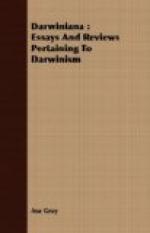Now, if the eye as it is, or has become, so convincingly argued design why not each particular step or part of this result? If the production of a perfect crystalline lens in the eye—you know not how—as much indicated design as did the production of a Dollond achromatic lens—you understand how—then why does not “the swelling out” of a particular portion of the membrane behind the iris—caused you know not how—which, by “correcting the errors of dispersion and making the image somewhat more colorless,” enabled the “young animals to see more distinctly than their parents or brethren,” equally indicate design—if not as much as a perfect crystalline, or a Dollond compound lens, yet as much as a common spectacle-glass? Darwin only assures you that what you may have thought was done directly and at once was done indirectly and successively. But you freely admit that indirection and succession do not invalidate design, and also that Paley and all the natural theologians drew the arguments which convinced your skeptic wholly from eyes indirectly or naturally produced.
Recall a woman of a past generation and show her a web of cloth; ask her how it was made, and she will say that the wool or cotton was carded, spun, and woven by hand. When you tell her it was not made by manual labor, that probably no hand has touched the materials throughout the process, it is possible that she might at first regard your statement as tantamount to the assertion that the cloth was made without design. If she did, she would not credit your statement. If you patiently explained to her the theory of carding-machines, spinning-jennies, and power-looms, would her reception of your explanation weaken her conviction that the cloth was the result of design? It is certain that she would believe in design as firmly as before, and that this belief would be attended by a higher conception and reverent admiration of a wisdom, skill, and power greatly beyond anything she had previously conceived possible.
Wherefore, we may insist that, for all that yet appears, the argument for design, as presented by the natural theologians, is just as good now, if we accept Darwin’s theory, as it was before that theory was promulgated; and that the skeptical juryman, who was about to join the other eleven in a unanimous verdict in favor of design, finds no good excuse for keeping the court longer waiting.[II-1]
III
NATURAL SELECTION
NOT INCONSISTENT WITH
NATURAL THEOLOGY
(Atlantic Monthly for July, August, and October, 1860, reprinted in 1861)
I
Novelties are enticing to most people; to us they are simply annoying. We cling to a long-accepted theory, just as we cling to an old suit of clothes. A new theory, like a new pair of breeches (the Atlantic still affects the older type of nether garment), is sure to have hard-fitting places; or, even when no particular fault can be found with the article, it oppresses with a sense of general discomfort. New notions and new styles worry us, till we get well used to them, which is only by slow degrees.




